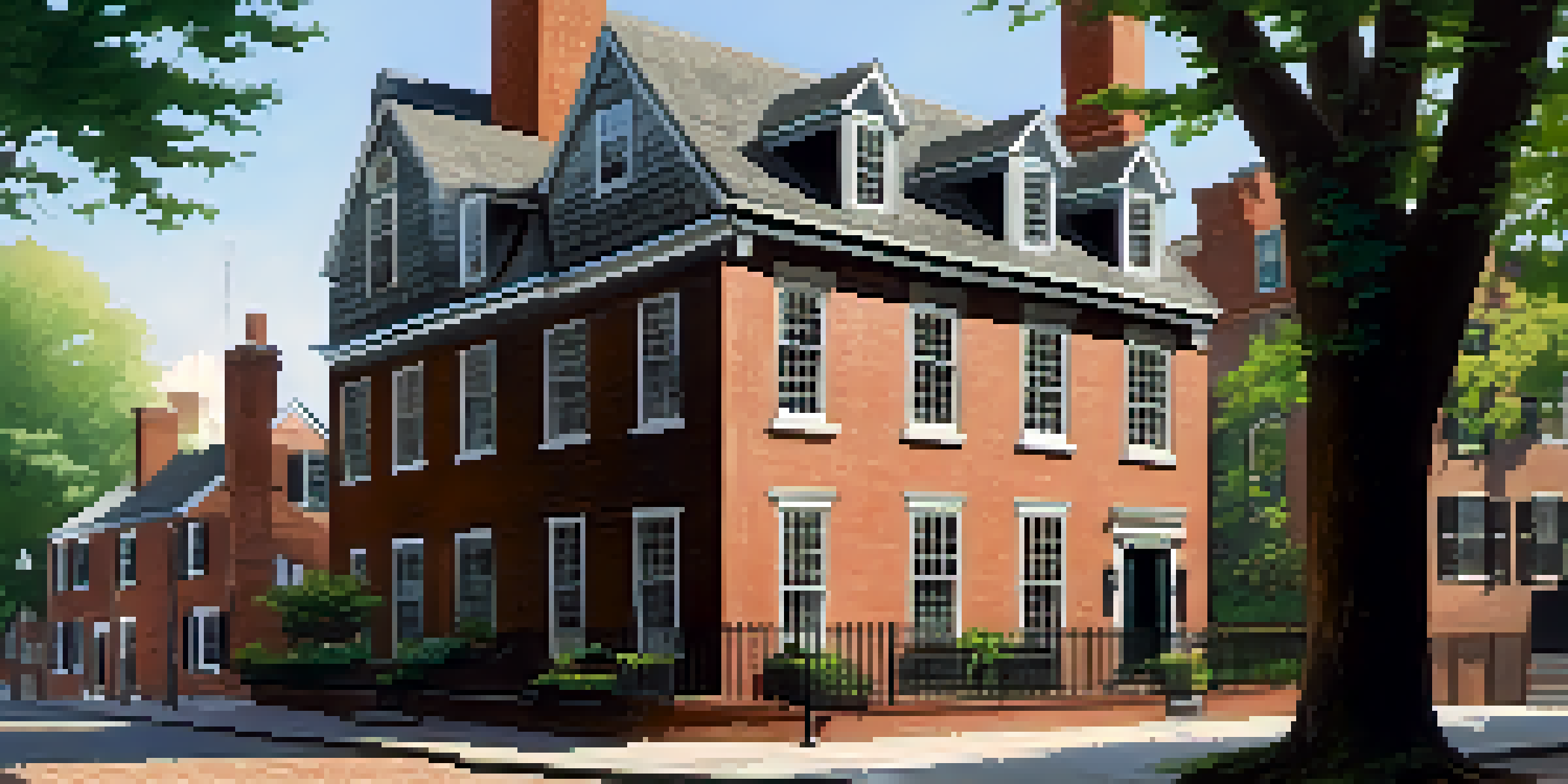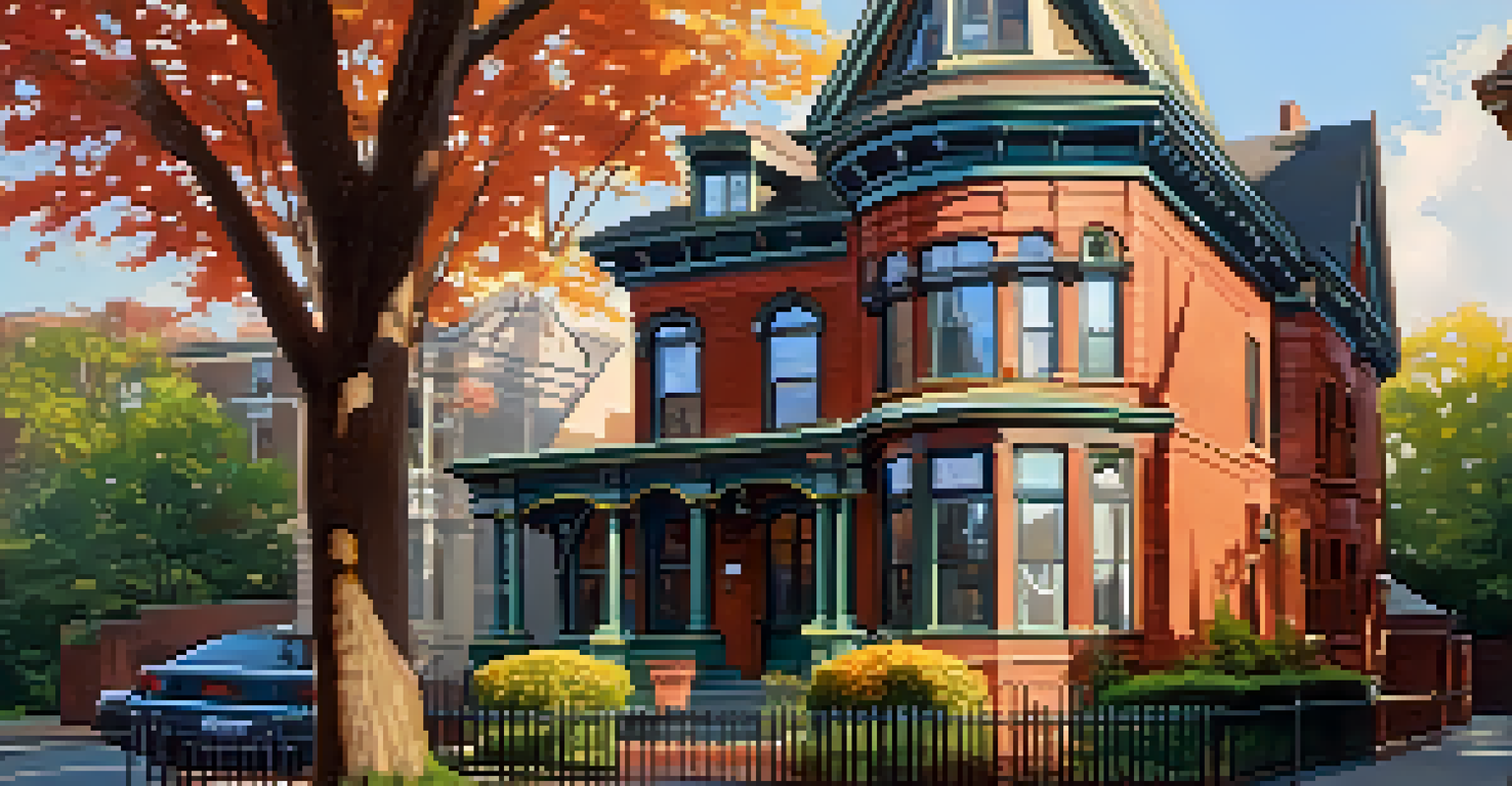The Unique Architectural Styles in Boston’s Historic Districts

The Charm of Colonial Architecture in Boston
Colonial architecture serves as the foundation of Boston's historic charm. Characterized by symmetry and simple lines, these buildings reflect the early American values of practicality and community. Notable examples include the iconic Paul Revere House and the Old North Church, which transport visitors back to the 17th and 18th centuries.
Architecture is the learned game, correct and magnificent, of forms assembled in the light.
The use of wood and brick in Colonial designs not only showcases the available materials but also illustrates the craftsmanship of the time. These structures often feature large chimneys, gabled roofs, and decorative elements like pilasters and cornices. Walking through the North End, you can still feel the echoes of early American life in these well-preserved homes.
What makes Colonial architecture particularly captivating is its storytelling aspect. Each building has a history, often intertwined with significant events in American history, making them not just structures but monuments to the past. They invite us to connect with the stories of those who lived and thrived in Boston long ago.
The Elegance of Federal-Style Architecture
Federal architecture emerged in the late 18th century and is known for its refined elegance. This style emphasizes symmetry and features decorative elements like fanlights and elliptical windows. In Boston, the Massachusetts State House is a prime example of this architectural movement, showcasing its iconic golden dome.

Buildings designed in the Federal style often incorporate brickwork with white marble or wooden accents, creating a striking visual contrast. The attention to detail in moldings and cornices reflects the era's commitment to artistic expression in architecture. As you stroll through Beacon Hill, you'll notice how these homes captivate with their grace and historical significance.
Boston's Rich Architectural Heritage
Boston's architecture showcases a blend of historical styles, each reflecting the city's evolving identity and cultural significance.
The Federal style not only represents a shift in architectural trends but also reflects the aspirations of a young nation. It symbolizes the hope for progress and sophistication, mirroring the cultural evolution of Boston during a transformative period. Each Federal-style building stands as a testament to the city's ambition and growth.
Victorian Influence: The Queen Anne Style
The Queen Anne style, a hallmark of Victorian architecture, adds a whimsical touch to Boston's historic landscape. This style emerged in the late 19th century and is known for its eclectic features, including asymmetrical facades and ornate details. A wonderful example can be seen in the Back Bay area, where many buildings showcase this distinctive flair.
We shape our buildings; thereafter they shape us.
Queen Anne homes often feature turrets, wrap-around porches, and a variety of textures that make each structure unique. The use of vibrant colors and diverse materials, such as brick, stone, and wood, creates an inviting and playful appearance. This style invites curiosity, encouraging passersby to explore the intricacies of each home.
What truly sets Queen Anne architecture apart is its embodiment of the Victorian love for individuality and craftsmanship. Each building tells its own story, reflecting the creativity and personality of its time. Exploring these neighborhoods feels like stepping into a living gallery of architectural art.
Beaux-Arts Architecture: Grandeur and Opulence
Beaux-Arts architecture, with its grandiose designs and classical influences, makes a striking impression in Boston. Originating from the École des Beaux-Arts in Paris, this style emphasizes grandeur through monumental structures and elaborate decorations. The Boston Public Library is a stunning example of this opulent architectural style.
Characterized by its use of columns, domes, and intricate sculptures, Beaux-Arts buildings convey a sense of permanence and importance. The rich detailing and grand staircases invite admiration and convey the aspirations of the city during the late 19th and early 20th centuries. These buildings are not just functional spaces; they are works of art that enhance the urban landscape.
Preservation Efforts Matter
Preservation initiatives are essential for maintaining Boston's unique character and allowing future generations to connect with their rich past.
Beaux-Arts architecture encapsulates the ambition of a city aiming to establish itself as a cultural and intellectual hub. The style reflects a time when architecture was seen as a means to inspire and elevate the community. Walking through these grand spaces, you can almost feel the weight of history and the dreams of those who built them.
Modernism in Boston: A New Architectural Era
As the 20th century dawned, Boston embraced modernism, which brought a fresh perspective to architectural design. Characterized by simplicity, functionalism, and a lack of ornamentation, modernist buildings sought to break away from traditional styles. The Boston City Hall stands out as a bold example of this architectural shift.
Modernist architecture often utilizes concrete and glass, emphasizing open spaces and natural light. This departure from ornate designs reflects a changing society that values efficiency and innovation. The stark lines and minimalist aesthetic of modern buildings can be seen throughout the Seaport District, where contemporary structures redefine the skyline.
Embracing modernism represents Boston's adaptation to a rapidly evolving world, showcasing creativity and forward-thinking. These buildings not only serve practical purposes but also challenge conventional notions of beauty in architecture. They invite conversation about the future of urban spaces and how they can reflect the values of a new generation.
Preservation Efforts: Safeguarding Boston's Heritage
With such a rich architectural history, preservation efforts in Boston are crucial for maintaining the city's unique character. Organizations and local governments work tirelessly to protect historic districts from development pressures that could compromise their integrity. The Boston Landmarks Commission plays a significant role in this endeavor.
Preservation is not just about saving old buildings; it's about honoring the stories and cultures they represent. By maintaining these structures, we preserve the community's identity and allow future generations to connect with their past. Walking through historic neighborhoods, you can see how these efforts contribute to a sense of continuity and belonging.
Exploring Architectural Diversity
Walking through Boston's diverse architectural landscape invites exploration and appreciation of the stories embedded in each structure.
The challenges of preservation often spark conversations about balance—between modern needs and historical significance. Engaging the community in these discussions ensures that diverse voices are heard, fostering a sense of shared responsibility. Every restored building becomes a symbol of resilience and a commitment to preserving the tapestry of Boston's architectural legacy.
A Walk Through History: Exploring Boston’s Architecture
Exploring Boston’s historic districts is like taking a walk through time, with each architectural style offering a glimpse into the city’s past. From the Colonial homes of the North End to the grandeur of Beaux-Arts structures, every corner tells a story worth discovering. Guided tours and self-exploration allow visitors to immerse themselves in this rich history.
As you wander the streets, pay attention to the details—each building has its own unique features, reflecting the values and aesthetics of its era. The interplay of different styles creates a vibrant tapestry that showcases Boston's evolution as a city. It’s not just about the buildings; it’s about the lives that have unfolded within their walls.

Engaging with Boston's architectural heritage offers a deeper understanding of its culture and identity. Whether you’re an architecture enthusiast or a casual visitor, the historic districts invite you to appreciate the beauty and significance of the structures around you. So grab your walking shoes and get ready to explore the architectural wonders that make Boston truly special.